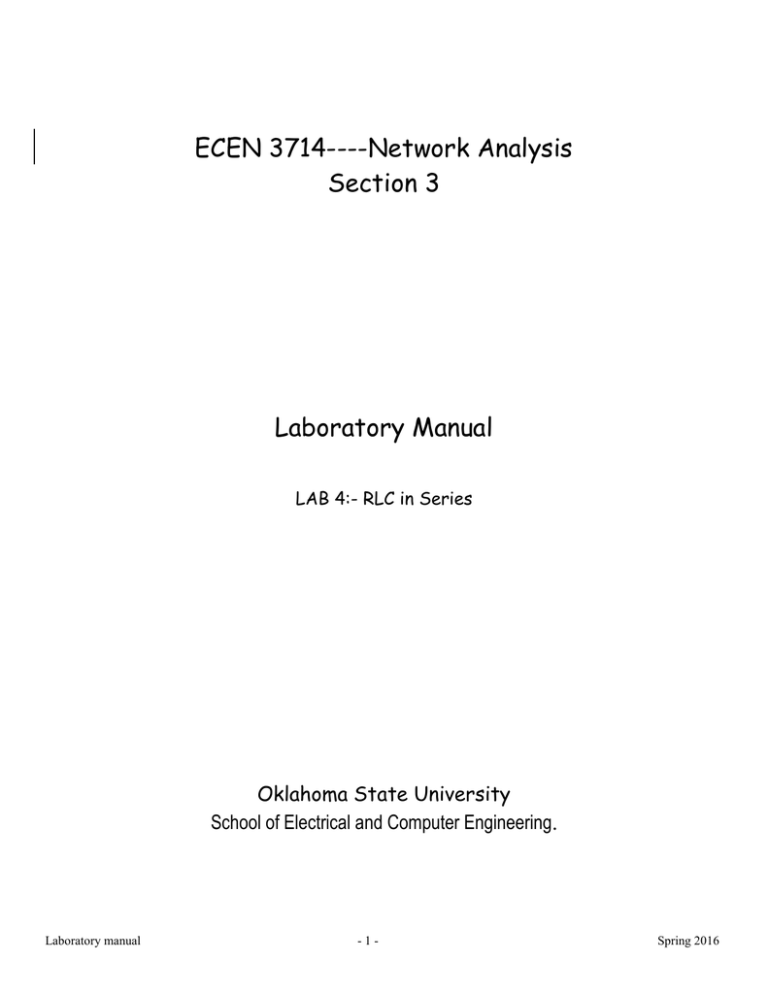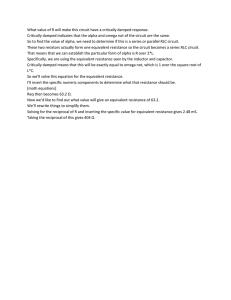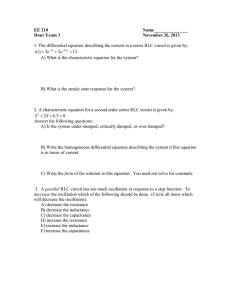ECEN 3714----Network Analysis Section 3 Laboratory Manual
advertisement

ECEN 3714----Network Analysis Section 3 Laboratory Manual LAB 4:- RLC in Series Oklahoma State University School of Electrical and Computer Engineering. Laboratory manual -1- Spring 2016 1. OBJECTIVE The objective of this laboratory section is to examine the resonance and damping features of the RLC circuits. You will measure the response of a series RLC circuit to a step input, and to learn the similarity and difference between nd the response of a series RLC circuit (a 2 order) and that of an RC or RL circuit. After this lab, you will be able to quantify the damped natural frequency and the decay (damping) time constant of a series RLC circuit using a step input. 2. RLC CIRCUIT AND STEP RESPONSE The exponential change of the voltage or current that you have examined associated with RC or RL circuits are actually the transient response of the RC or RL (first-order) circuits. For any circuit, it takes time, shorter or longer, for the output to become stabilized for a given input (stabilized does not mean constant). How the circuit stabilizes is the transient response of the circuit. In this lab you will examine the transient response of series RLC circuits. A square wave form will be applied to the series RLC circuit to analyze the transient response. The transient response of an RLC circuit is determined by the damping factor (equivalent to the decay constant) and the resonance frequency o. For a series RLC circuit, R 2L 0 1 LC Depending on the values of R, L, and C, the circuit can be over-damped (when > ), critically damped (when = ); or under-damped (when < ). For the under-damped case, the voltage or current for the passive elements all have the pattern of oscillating with exponentially decaying amplitude similar to the one shown in below which can be described in a general form as: X (t ) et [ A cos d t B sin d t ] d o 2 2 where the coefficients A and B are determined by the initial conditions of the circuit. The decaying of the envelope of the oscillation has a time constant of = 1/ and the decaying oscillation has a frequency (called damping frequency or damped natural frequency) of d which is 2 times the inverse of the period T. 3. PRE-LABORATORY ASSIGNMENT The pre-lab assignment MUST be completed before you perform the hands-on laboratory measurement. The prelab accounts for 40% of the lab-5 grade. Figure1 3.1 Pre-Lab Assignments 3.1.1 For circuit (A), determine if it is over-damped, critically-damped, or under-damped. If it is an under-damped circuit, find the natural frequency (ω0), and the damped natural frequency (ωd). -------10% 3.1.2 For Vin 5u (t ) , find Vout of (A) using PSPICE or MATLAB. Plot Vin and Vout in one figure------ 10% Laboratory manual -2- Spring 2016 3.1.3 Choose three resistor values (or ranges, you are going to use those values in the lab) in circuit (B) for the circuit to become under-damped, critically damped, and over-damped. Confirm using PSpice ----- 15% Design a first order (RC or RL) circuit that has a SIMILAR (as close as possible) decaying time-constant as the under-damped circuit that you have chosen for circuit (B). Verify with PSpice----------------------- 5% 3.1.4 Bring your own thumb drive, and check the data saved in the drive before leaving lab. No credits will be given for the data lost. 4.1 4. LABORATORY ASSIGNMENT Activities: 4.1.1 Implement the circuit (A), using a square wave with frequency & amplitude of your choice to confirm the response (over-, or critically, or under- damped) of the circuit calculated in 3.1.2 and simulated in 3.1.3. 4.1.2 Implement the circuit (B) using the three different resistor values you have chosen in 3.1.4. Use a square wave with frequency & amplitude of your choice. For the critically damped case, you may need to adjust the resistor in order to reach the critically damped condition. Question: how will you judge that you have reached the critically damped condition? Record the responses in all three conditions. 4.1.3 For only the under-damped case you set in 4.1.2, quantify the damped natural frequency and the decay time-constant. You may use this format to keep record of the circuit parameter. Parameter Measured Calculated % Error , time constant d 4.1.4 Measure the response of the first-order circuit you designed in 3.1.5 for the same input used for 4.1.2. 4.2 Laboratory Report:4.2.1 Cover page------------------------2% The cover page should include (1) the course name, lab-sections, dates, lab numbers; (2) the names of the group members, and the signatures of the members. The lab and the report should be the work of active collaboration within the lab-group (each member of the group should actively be involved in preparing the single pre-lab, performing the hands-on assignments, and producing the post-lab reports. What you have learned/observed in lab may be of critical importance to tests. No discussion with other group members is allowed. 4.2.2 Introduction- ---------------------Describe the objective of this laboratory section 3% 4.3.3 Completed pre-lab (with the signature of TA): ---------------- 40% 4.3.4 Results and data analysis by referring to pre-lab results: ------- 45% Based on the order of the laboratory activities defined in 4.1, organize the predicted and observed responses of the circuits. This section shall include the following components for each experimental set up of 4.1.1—4.1.4: The method of measuring the damping factor in under-damped case, show with figure -5% The method of measuring the damped natural frequency, show with figure ---5% Describe your criteria of finding the critically damped case in experiment. 5% Results of 4.1.1, including the saved waveforms 5% Results of 4.1.2, including the predicted and measured responses at the three cases, under-damped, critically damped, and over-damped cases. 15% The tabular results of 4.1.3, 5% Results of 4.1.4, including the predicted and measured responses 5% 4.3.5 Discussions and conclusion: ----------10% What general conclusion can you made out of this lab? Use relevant equations to support your findings if necessary. For nd a 2 order series RLC circuit, which parameters determine the oscillation of the circuit? Which parameters determine the damping of the circuit? Is it possible to make an RL circuit oscillate? Laboratory manual -3- Spring 2016


